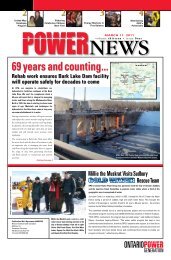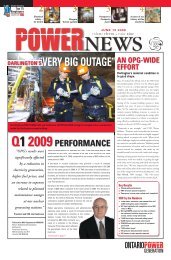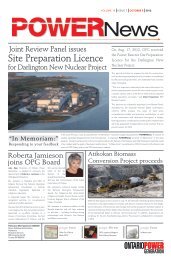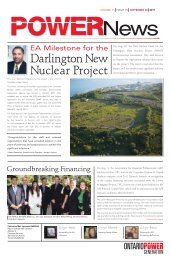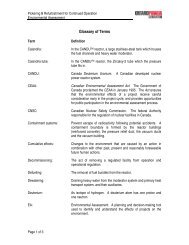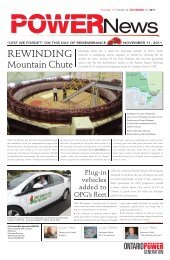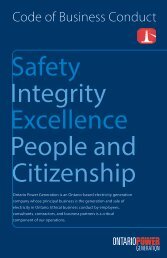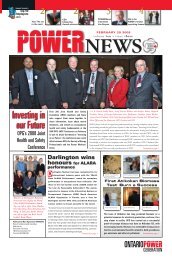Draft Scoping Information Document - Ontario Power Generation
Draft Scoping Information Document - Ontario Power Generation
Draft Scoping Information Document - Ontario Power Generation
You also want an ePaper? Increase the reach of your titles
YUMPU automatically turns print PDFs into web optimized ePapers that Google loves.
July 2011<br />
<strong>Draft</strong> <strong>Scoping</strong> <strong>Information</strong> <strong>Document</strong> - Proposal by OPG - Refurbishment and<br />
Continued Operation - Darlington Nuclear Generating Station, Clarington, <strong>Ontario</strong><br />
Use of any software tool is acceptable if it can address risks to VECs explicitly or<br />
by reasonable analogy. If the approach of Environment Canada & Health Canada<br />
[Reference 8] is not used, the model structure and implementation should be<br />
described in detail. It is not acceptable to simply refer to a software handbook. A<br />
few representative worked examples of simple dose calculations starting with<br />
media and/or food concentrations should be presented, regardless of the approach<br />
taken, to allow independent validation.<br />
4. ASSESSMENT AND MITIGATION OF ENVIRONMENTAL<br />
EFFECTS<br />
4.1 Description of Assessment Methods<br />
The consideration of environmental effects in the screening should be done in a<br />
systematic and traceable manner. The assessment methodology will be<br />
summarized in the screening report. The results of the assessment process should<br />
be clearly documented using summary matrices and tabular summaries where<br />
appropriate.<br />
In describing methods, the proponent must document how it used scientific,<br />
engineering, traditional and other knowledge to reach its conclusions.<br />
Assumptions must be clearly identified and justified. All data, models and studies<br />
must be documented such that the analyses are transparent and reproducible. All<br />
data collection methods must be specified. The uncertainty, reliability and<br />
sensitivity of models used to reach conclusions must be indicated. The sections in<br />
the EIS regarding existing environment and potential adverse environmental<br />
effects predictions and assessment must be prepared using best available<br />
information and methods, to the highest standards in the relevant subject area. All<br />
conclusions must be substantiated.<br />
In preparing the EIS, the proponent is encouraged to make use of existing<br />
information relevant to the project (e.g., Reference 9). When relying on existing<br />
information to meet the requirements of various sections of the <strong>Scoping</strong><br />
<strong>Information</strong> <strong>Document</strong>, the proponent must either include the information directly<br />
in the EIS or provide a summary and clear direction (e.g., through crossreferencing)<br />
to where the information can be obtained. When relying on existing<br />
information, the proponent must also comment on how representative the data are,<br />
clearly separate factual lines of evidence from inference, and state any limitations<br />
on the inferences or conclusions that can be drawn from them.<br />
4.2 Identifying Project-Environment Interactions<br />
The initial stage of the assessment requires the identification of project activities<br />
that may interact with the biophysical environment or socio-economic<br />
environment during project implementation and during relevant malfunctions and<br />
accidents. The identification of potential interactions is performed using a<br />
Project-Environment Interactions Matrix (Appendix C). Those interactions that<br />
could adversely interact with the environment will be identified through the EA<br />
e-DOC 3734740 - 18 -<br />
CEAR 11-01-62516





